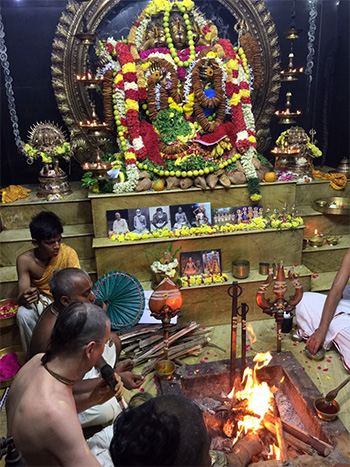Question: Who is the founder of Hinduism?
Hinduism actually has no single founder as far as the modern history is concerned. The ancient scriptures of India claim the religion is originally established by God Himself (dharman tu sakshad bhagavat pranitam).
From the scriptural viewpoint, this religion or dharma, manifests after every creation by the will of the Lord. After the present cyclical creation, the Supreme Lord Narayana instructed the first living entity within the universe, Brahma, in the matters of religion. Brahma in turn instructed this same science to his son, Narada, who in turn passed this knowledge on to his disciple Vyasa Mahamuni. In this way the ancient religion has been passed down in a chain of disciplic succession directly from God for countless millions of years.
This Vedic religion is therefore known as sanatana dharma, or the “eternal religion”, for it predates all man-made conceptions of time and space. We should not confuse this sanatana dharma with any sectarian religious faith, for the true sanatana dharma is the very function of the soul, as inseparable as liquidity from water.
The modern word “Hinduism” is a term developed approximately 700 years ago by the Muslim invaders of India. There was a river by the name Sindhu, which was mispronounced by the invaders as Hindu. All people living beyond that river, regardless of their religious beliefs, were called as Hindus. Thus some may mistakenly conclude that it is possible to trace out the historical origins of the ancient religion of India based on the historical use of this word.
We should know that in the ancient “Hindu” scriptures we will not find the word Hindu mentioned even a single time, but instead we will find the words sanatana-dharma (eternal religion), vaidika-dharma (religion of the Vedas), bhagavata-dharma (religion of God), etc. This dharma is ever fresh and eternal. It is stated in the Vedic scriptures that whenever this message of dharma is lost, God Himself will incarnate to reestablish it:
yada yada hi dharmasya
glanir bhavati bharata
abhyutthanam adharmasya
tadatmanam srijamy aham
“Whenever and wherever there is a decline in religious practice, O descendant of Bharata, and a predominant rise of irreligion – at that time I descend Myself to reestablish it.” (Bhagavad Gita 4.7)
One such incarnation of the Supreme was that of Lord Krishna, who appeared 5,000 years ago to reestablish dharma by speaking the Bhagavad Gita on the battlefield of Kurukshetra.
In the Vedic history, there are countless saints who have come and propagated the ancient teachings found in the Vedic literatures, but none can be called as the founder. Each one was a disciple of another guru, and each one was passing on the same knowledge as had been taught to him by his guru. This is the Vedic system – there is no founder, because everyone is first and foremost a disciple. Dharma cannot be man-made, for it is defined as the direct instructions of God – dharman tu sakshad bhagavat pranitam.
Receive our daily email newsletter on Hinduism, Yoga, Meditation, Ayurveda and Natural Healing.







So we can say that father of hindu dharm is lord narayana!
Feature of Hinduism